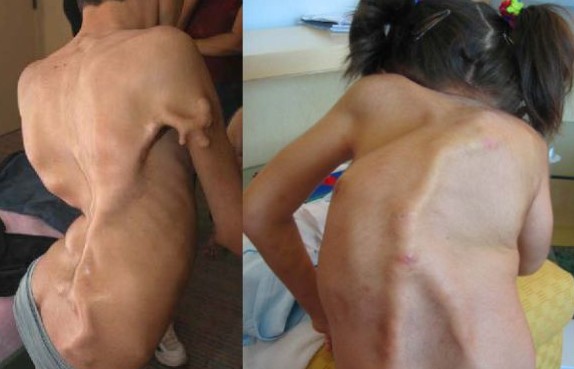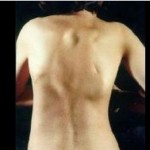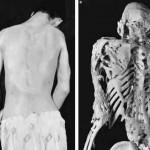Fibrodysplasia Ossificans Progressiva – Pictures, Symptoms, Treatment
What is Fibrodysplasia Ossificans Progressiva?
Fibrodysplasia Ossificans Progressiva is a genetic disorder that affects the muscular and connective tissues in the human body. It is responsible for body movements that then transform the connective tissue into bone, called ossification. When ossification occurs, malformation of a bone in the external area of the skeleton will take place. Also called the extra-skeletal or heterotopic bone, it is confined to movement in the spine, chest, neck, shoulders, wrists, elbows hips, knees, elbows hips, ankles and jaw but does not restrict progression.
FOP is an atypical disorder because it only affects one in two million people; males and females are both affected in an equal manner. Surgery is prohibited and it can be dangerous to even fall down, because this may cause swelling and inflammation in the muscle and may intensify rapid ossification in the area that is injured.

Symptoms
Symptoms of Fibrodysplasia Ossificans progressive may include:
- Vagus Deviation, a malformation in an outward appearance of the great big toe, the hallmark symptom found in newborns.
- During the first 10-20 years of life, continuous loss of mobility as the joints become affected and growths develop from the jaw, neck down to the spine, thoracic area, knees, and feet, just as bones would grow in a fetus.
- Difficulty or inability to fully open the mouth, causing a difficulty in speaking and eating. This may lead to malnutrition as the person afflicted cannot chew without causing a growth.
- Painful flare-ups that last up to 6 -8 weeks. The first flare up that leads to the development of the disorder usually occurs before the age of 10.
- Swelling of the tissue and joint stiffness that leads to extreme discomfort.
- Some may suffer from low-grade fever.
- Development of tumors in the connective tissue and muscle tissue. These lesions lead to formation of bone outside the skeleton called heterotopic ossification in the axial muscles, the fascia, in the ligaments, the tendons, and the joint capsules.
- Breathing difficulties as a result of extra bone formation around the rib cage, limiting expansion of the lungs, which leads to TIS (thoracic insufficiency syndrome)
Causes
Germline mutation – Fibrodysplasia Ossificans Progressiva is a genetic disorder in which there is a mutation in a gene. The gene mutation is responsible for FOP and it is already present at birth. In the tissues and cartilaginous area of the skeletal muscles the gene is present because it also helps in regulating the development of bones and muscles in the body. It also contributes to the maintenance in cartilage replacement into a bone, which takes place as a person matures. However, mutation of this gene tells the body to continue to grow bones after the fetus is fully developed in the womb, rather than stop once all bones and tissues are fully formed.
Random occurrences – Some cases FOP are not inherited. The mutation starts at the development of an egg, sperm and embryo.
Inheritance – Fibrodysplasia Ossificans Progressiva is inherited through a autosomal dominant allele which means it is passed on by only one parent. This is enough for the child to develop the disorder. A parent with FOP has a 50% chance that his/her child will have Fibrodysplasia Ossificans Progressiva. However, this disorder is rarely inherited because most people who have the disease are unable to bear a child.
Diagnosis
FOB is a very uncommon disorder and it is oftentimes:
- Diagnosed by its signs and symptoms (tumor-like swellings on the neck, head, shoulders, back and Vagus deviation)
- 87% are misdiagnosed with other diseases such as Cancer, aggressive juvenile fibromatosis, and progressive osseous heteroplasia.
Treatment
- Early detection is the best way to lessen the progression of the disorder, but not to treat the disease. Surgical removal of the excess bone is not advisable because it may result to more bone formation. There are no effective medical therapy known for FOP; bisphosphonates and corticosteroids are beneficial only during the episodes of flares.
- Lessening the progression by avoiding bumps and falls.
- There are different medical measures to increase pulmonary function, decrease respiratory compromise, and prevent pneumonia and influenza. These are all helpful in decreasing the number of deaths from thoracic insufficiency syndrome.
- Rehabilitation approaches should be focused on improving daily activities. Occupational therapy and vocational education consultations may be extremely useful for FOP patients.
Scientists discovered in 1999 that squalamine in sharks that might be useful in treating those individuals who are suffering from FOP. Squalamine is an antiangiogenic and can prevent the growth of blood vessels in cartilaginous tissue, thus preventing bone calcification in sharks. In 2002 they started a trial of squalamine. It was terminated because squalamine is a different compound found in sharks that has no such properties of preventing ossification in humans.
Prognosis & Life Expectancy
Unfortunately, due to lack of treatment, the fact that the disease is incurable and fatal, only management of the symptoms, pain, and discomfort are done using prophylactics.
Fibrodysplasia Ossificans Progressiva is a incurable disease at this time so the life expectancy of individuals who suffer from FOP is poor. According to research, the life expectancy of persons with Fibrodysplasia Ossificans Progressiva is up to 41 years of age, but some have survived until the age of 60. Many FOP patients suffer from thoracic insufficiency syndrome (TIS) so some die before the age of 40-41 years old.
FOP is a progressive disorder it gets worse as a person ages. It differs from person to person in severity and is very unpredictable.



